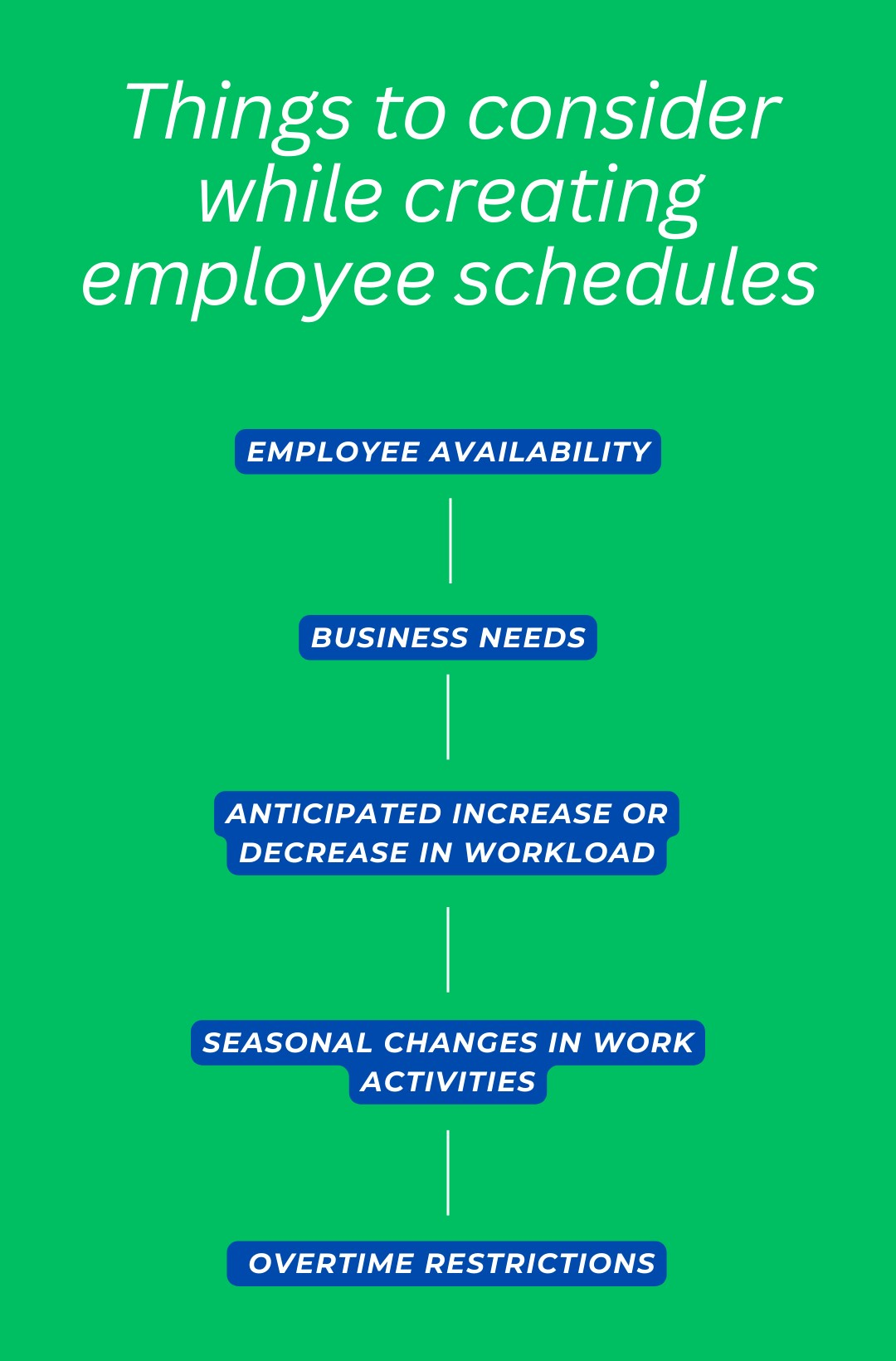A Guide to Successful Scheduling Management: Strategies for Workforce Optimization

Table of contents
- What is Workforce Management Scheduling?
- Why is Workforce Management Scheduling Important?
- What are the Challenges of Workforce Management Scheduling?
- How to Streamline Your Workforce Management Scheduling?
- Wrapping up
- Frequently Asked Questions
- 5.1. What is the role of a workforce scheduler in scheduling management?
- 5.2. How does workforce management scheduling software differ from traditional scheduling methods?
- 5.3. How can workforce management scheduling benefit my business?
- 5.4. How can I overcome the challenges of workforce management scheduling?
In the modern business landscape, optimizing your workforce is key to staying competitive and efficient. One critical aspect of achieving this optimization is workforce management scheduling.
In this comprehensive guide, we’ll explore the importance of workforce management scheduling, the challenges associated with it, and, most importantly, strategies to overcome these challenges and create an effective scheduling process.
We’ll also delve into the benefits of using workforce management scheduling software, helping you choose the right solution for your needs.
What is Workforce Management Scheduling?
Workforce management scheduling involves the planning, tracking, and management of employee work hours, shifts, and assignments.
It’s a systematic approach to organizing your workforce to meet business objectives efficiently. This process ensures that the right employees are in the right place at the right time.

Why is Workforce Management Scheduling Important?
Now that you know what scheduling management means, let’s take a quick glance at the benefits of workforce scheduling:
- Efficiency: Proper scheduling ensures that you have the right number of employees to meet demand while minimizing overstaffing or understaffing.
- Productivity: It enhances productivity by aligning employee skills with specific tasks, maximizing output.
- Cost Control: Effective scheduling management helps control labor costs by minimizing overtime and reducing inefficiencies.
- Employee Satisfaction: A well-organized schedule that takes employee preferences into account can boost morale and reduce turnover.
Here are a few stats that you should know to understand the importance of employee scheduling:
- 37% of shift workers perceive limited career advancement prospects within their organization.
- Slightly over half of shift workers classify themselves as essential employees; the remaining consider the opposite, which can lead to reduced productivity.
- Irregular or on-call shifts are worked by 8% of salaried employees and 6% of hourly workers.
- Employees earning less than $22,500 annually are more prone to having irregular work schedules compared to those with higher income levels.
- Approximately 15% of individuals in sales and related occupations are subject to irregular or on-call work schedules.
What are the Challenges of Workforce Management Scheduling?
You can only reap the benefits of WFM scheduling when you understand and overcome the challenges associated with workforce scheduling. So, what exactly are these challenges? Let’s find out!
- Complexity: As businesses grow, scheduling becomes more complex due to various roles, departments, and shifts.
- Regulatory Compliance: Adhering to labor laws and regulations can be challenging, especially when you’ve a diverse workforce working from several locations.
- Communication: Communicating schedules and changes to employees in a timely and efficient way can be difficult without a proper workforce scheduler.
- Data Management: Handling and organizing employee data for scheduling can be time-consuming, especially when you depend on manual methods.
So, what exactly do shift employees expect for a more fulfilling work environment? (Source)
- 65% of employees prefer advanced notice of work schedules.
- 53% of employees feel clear communication of available shifts is vital.
- 47% of employees appreciate records, including hours, changes, and consent.

How to Streamline Your Workforce Management Scheduling?

To optimize your workforce and ensure smooth resource management, you need to have robust strategies to streamline WFM scheduling. What are these strategies, and how can you implement them into your organizational fabric? Here’s how:
Develop a Scheduling Process
Defining a streamlined process is the cornerstone for successful scheduling management. Developing the scheduling process involves the following stages:
Define Your Goals
The first step in creating an effective scheduling process is to define your goals. What do you want to achieve through scheduling? Whether it’s cost reduction, improved productivity, or better employee satisfaction, clear objectives will guide your scheduling management efforts.
Identify Your Scheduling Constraints
Every business has constraints that affect scheduling. These can include budget limitations, labor laws, and facility constraints. Identify these constraints to ensure that your schedules remain compliant and realistic.
Determine Your Staffing Needs
Assess your staffing requirements based on demand forecasting. Consider peak periods, seasonal variations, and special events to determine how many employees you need and when.
Choose a WFM Scheduling Method
There are various WFM scheduling methods, such as fixed, flexible, and rotating schedules. Choose the one that aligns with your goals and staffing needs.
For example, a flexible schedule may suit businesses with varying demands, while a fixed schedule might be more appropriate for consistent operations.
Create a Schedule Template
Creating a schedule template streamlines the scheduling process. Use it as a foundation for future schedules, making adjustments as needed.
Templates save time and maintain consistency. Several top-notch workforce schedulers feature inbuilt templates for better optimization.
Implement Your Scheduling Management Process
You’ve determined a scheduling process. Now, it’s time to implement it across your organization. How?
Collect Employee Data
Collect and organize employee data, including skills, availability, and preferences. This data will help you create schedules that consider each employee’s capabilities and needs.
Create Employee Schedules
Generate schedules using a suitable workforce management scheduling software. The schedules should match employee availability, skills, and the staffing needs you identified earlier.
Communicate the Schedule to Employees
Share schedules with employees in advance, using digital tools or apps for real-time access. Ensure that employees are well-aware of their shifts and responsibilities.
Also Read: Shift Work Scheduling: Fundamentals, Challenges, and Benefits
Manage Your Schedule
Your workforce management scheduling doesn’t end with implementation. You need to regularly monitor and update the process.
Track Employee Attendance
Implement a system for tracking employee attendance. This helps in ensuring that employees adhere to their schedules and allows for swift action in case of deviations.
Make Adjustments to the Schedule as Needed
Schedules are not set in stone. Be flexible and willing to make adjustments when necessary. This might involve accommodating employee requests, addressing unexpected absences, or adapting to changing business needs.
Manage Employee Time Off
Incorporate a process for handling employee time-off requests. Ensure that employees can request time off and that their requests are evaluated fairly.
Use Workforce Management Scheduling Software
Using workforce management scheduling software can help reduce scheduling time and streamline the entire process.
Features of Workforce Management Scheduling Software
Workforce management scheduling software offers several features that can simplify the scheduling process:
- Automation: The software automates many scheduling tasks, saving time and reducing errors.
- Integration: It can integrate with other systems, such as HR and payroll, streamlining data management.
- Forecasting: These workforce scheduler tools often include demand forecasting, helping you plan for fluctuations in demand.
- Reporting: Detailed reports provide insights into scheduling efficiency, helping you make data-driven decisions.

Benefits of Using Workforce Management Scheduling Software
The benefits of using workforce management scheduling software include:
- Efficiency: Automated scheduling reduces the time spent on manual tasks.
- Cost Savings: By optimizing schedules, you can reduce labor costs.
- Compliance: These tools help ensure that schedules adhere to labor laws and regulations.
- Employee Satisfaction: Features like shift swapping and self-service scheduling can improve employee morale.
How to Choose the Best Workforce Management Scheduling Software for Your Needs
Selecting the right software involves considering factors like your business size, budget, and specific requirements.
Look for user-friendly interfaces, scalability, and robust customer support. It’s essential to choose a workforce management scheduling software that aligns with your scheduling objectives.
Wrapping up
Effective workforce management scheduling is critical for optimizing your business operations. By following the strategies highlighted in this guide, you can create a scheduling process that enhances efficiency, controls costs, and improves employee satisfaction.
Using workforce management scheduling software further streamlines the process, providing numerous benefits.
If you’re interested in taking a step towards efficient scheduling management, consider exploring ProHance, our workforce management scheduling solution.
We offer features and benefits that can help you achieve your scheduling objectives without the need for manual, time-consuming efforts. Contact us to learn more about how ProHance can assist you in achieving workforce optimization.
Frequently Asked Questions
Q1. What is the role of a workforce scheduler in scheduling management?
A workforce scheduler plays a vital role in scheduling management by creating and optimizing employee schedules. Their primary task is to ensure that shifts are assigned efficiently, taking into account factors like employee availability, skills, and staffing needs.
Q2. How does workforce management scheduling software differ from traditional scheduling methods?
Workforce management scheduling software automates and streamlines the scheduling process.
It offers features such as automation, integration with other systems, and demand forecasting, which traditional methods often lack. This software is designed to improve efficiency, reduce costs, and enhance compliance with labor laws.
Q3. How can workforce management scheduling benefit my business?
Workforce management scheduling can benefit your business in several ways. It can help improve productivity, control labor costs, and enhance employee satisfaction.
Additionally, it enables you to create schedules that align with your business objectives, leading to better overall efficiency.
Q4. How can I overcome the challenges of workforce management scheduling?
Overcoming scheduling challenges involves creating a robust scheduling process, collecting employee data, and using software to streamline operations.
It’s also crucial to communicate schedules effectively and remain adaptable to changes. By implementing best practices and leveraging technology, many of these challenges can be addressed.


